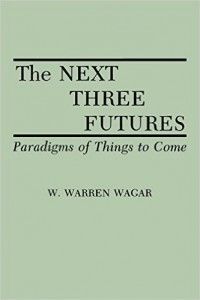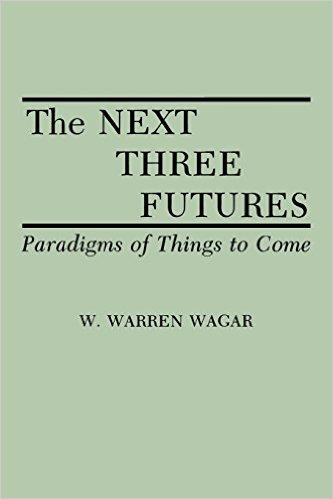I’ve been meaning to revisit – or visit for the first time — foresight classics. I started slowly with a two-part review of Olaf Stapeldon’s Last and First Men and Starmaker (part 1) and (part 2) in 2013 and and in 2014 I revisited Future Shock for APF Compass. This year it’s W. Warren Wagar’s The Next Three Futures: Paradigms of Things to Come, which came out in 1991. Before I get into it, an early New Year’s resolution is shoot for a quarterly schedule in 2016.
and Starmaker (part 1) and (part 2) in 2013 and and in 2014 I revisited Future Shock for APF Compass. This year it’s W. Warren Wagar’s The Next Three Futures: Paradigms of Things to Come, which came out in 1991. Before I get into it, an early New Year’s resolution is shoot for a quarterly schedule in 2016.
Wagar taught courses on the future for many years at SUNY Binghamton, such as “History of the Future,” “World War III,” and “Alternative Futures.” Before getting into the main idea of the book, he did a brief review of the state of the field, that brought up a few interesting items. For instance, he estimates that in 1991 that “there may be only a few hundred full-time, self-styled futurist in the US and a few hundred more elsewhere.” We are still working on getting a handle of the number of futurists today, but it’s probably safe to say that there may be an order of magnitude more. He also noted the need for a “unified theory of futures inquiry,” another issue that we’re still wrestling with today. He also suggests that HG Wells ought to be noted as the founder of the study of alternative futures. He surveyed some of Well’s work, including his call for “Professors of Foresight.” While there have been professors exploring the study of the future since the 1970s, my title is explicitly Assistant Professor of Foresight – the prophecy has been fulfilled! An interesting tidbit.
To the book. What is notable is his categorization of paradigms for thinking about the future as technoliberals, radicals, and counterculturalists. He suggested that the technoliberals are most often in North America and includes an “abiding faith in the power of technology and managerial technique to solve problems.” Herman Kahn was a leading figure in this school. The radicals are equated with socialists, social-democrats or Marxists. They are not many within the “institutionalized futures movement” who hold this view. Nonetheless, the view hopes for “the demise of the capitalist world-system, with all its fester injustice and its replacement by some form of workers’ polity or commonwealth. He cited Barry Commoner and Robert Heilbroner as figures in this school. Finally, the counterculturalists are “more concerned with the quality of life than with its quantities….and a preference for local and communal autonomy.” He noted a close association with New Age or transformational ideas. Willis Harman and Hazel Henderson are cited as representative figures here.
The balance of the book explores different aspects of the future, such as the environment, economy, war, and living, through these three paradigms. The timeframe often extends into the distant future, as he notes that changing paradigms takes a long time. I had a few reactions to the book. First, I enjoyed his survey of the field and its history. The substantive chapters on the future were interesting and worthwhile, and brought me back to my start as a futurist in the early 1990s and the state of thinking about the future back then. His three paradigms scheme made sense. I think technoliberals and counterculturals are alive and well today, but perhaps under different headings. The radical paradigms seems the most dated of the three, and likely reflects the specter of the Cold War. But even here I wouldn’t be too quick to dismiss the notion. Futurists and others today are in the heat of debate on how to deal with the coming automation of more and more work and what that means for how we organized economic activity. Various forms of a basic or guaranteed income are being discussed fairly routinely. These ideas fit snugly into the radical scheme, although one is typically careful today to omit the words socialism and communism in many areas, certainly in the US.
In my own work, Consumershift, I’ve adapted the ideas and language of Inglehart’s World Values Survey and Beck & Cowan’s Spiral Dynamics to talk about traditional, modern postmodern, and integral worldviews. The technoliberal paradigm is consistent with a modern worldview. The radical is a bit trickier to place. I would put it in modern, based on its emphasis on materialism, but also recognizing that it was called for the demise of the modern project. The counterculturalists fits nicely into the postmodern worldview, perhaps with a smattering of integral.
It was an enjoyable read that caused me to reflect and also helped to reinforce a sense of continuity with our futurist predecessors. Next up is Macrohistory and Macrohistorians – we’ll see how well I do on my New Year’s Resolution. – Andy Hines.

Thanks, Andy! Thought-provoking review.
Only in America would you think that the radicals were modernists. Social democrats, maybe, and it’s all but impossible to be a meaningful social democrat in a neo-liberal world – but the socialists and Marxists I read are fighting with the counter-culturalists for a different way of understanding (and creating) the post-modern project. It’s still about economics, yes, but it’s also about power and distribution – and not necessarily growth, which I’d suggest is an essential element in the modernist project. Paul Mason is a case in point (Post-Capitalism), or Srnicek and Williams (Inventing the Future), or the politics of Podemos in Spain.
Hey Andrew, I thought I was pretty clear about my uncertainty on that point (ha!): “The radical is a bit trickier to place. I would put it in modern, based on its emphasis on materialism, but also recognizing that it was called for the demise of the modern project.”
The hazards of thinking things through on the fly in a blog. Great to have folks willing to improve the discussion, thanks!
Andy, I don’t recall this work coming up for discussion in my Intro class, although I wish it had – I’ll have to look it up!
Respectfully, I’d suggest that putting the radicals in with the technoliberals in the “modernist” category is a good fit. As I read more contemporary sociologists and social philosophers, I see that radicals and technoliberals represent opposing perspectives on a common problem: modernity. The difference I see is that technoliberals are all about accepting modernity without question, whereas radicals explicitly call the modern project into question. But I don’t see it as being about materialism, per se: I see the distinction between the two positions as being about the individual’s responsibility to society. I see technoliberals taking the position that technologies will solve our problems; that unhindered development will result in the technologies humanity needs; and individuals thus owe society no loyalty, since society tends to slow technological development. The radical position, then, would be that individuals exist because of society, and that technology needs to be harnessed to social service.
Andrew, you wrote, “It’s still about economics, yes, but it’s also about power and distribution – and not necessarily growth, which I’d suggest is an essential element in the modernist project.” As I’ve come to see it, growth is a capitalist imperative which, while closely associated with “progress”, is not exactly the same. I’ll grant progress as “an essential element in the modernist project,” and I’m all too happy to call the notion of progress as an unmitigated good into question. But I’m curious about “economics . . .power and distribution.” When is economics not about power and its distribution?
Thanks Mr Andy Hines. I read your comment about Warren Wagar’s The Next Three Futures: Paradigms of Things to Come (1991) and his three paradigms: technoliberalism, radicalism, and counterculturalism. Its an interesting book like few for discussion. In my regular revision´s books or articules its very difficult found this jewel
I have my first impressions: i ask where is the answer about to construct paradigms?: may be at historical epistemology and ontology, philosophy, Physics, or Economy. Por example Im working with Economy and the relationship with Physics because theoric physic has a revolutionary evolution and many answers for the future, mainly in cultural evolution (According with Shain, NASA, 1999). And I refer to Three economics paradigms, with Mirowski´s help: Neo Classical, marxist (radicalism in Wagar version) and Ambiental in relationship with their origins and developments.
Them if we try and compare its possible evolve Thecnoliberalism in the radicalism vision, but if we see panoramic vision about Future Studies and Megatrends, Future researchers are a lot and radicalism a minority. Why?. Maybe for ideological reasons.
Your answer is clearly: ” Futurists and others today are in the heat of debate on how to deal with the coming automation of more and more work and what that means for how we organized economic activity”. Futurists have a hard work with world future, for several reasons: Climate change, rapid Technology change, Human conflicts. Futurists must have a consistent and coherent “Body of Knowledge”
Good synopsis Andy. Although I wonder if the 3 categorizations are time specific. Wagar’s assessment was published in 1991 almost 2 decades earlier. So am guessing his categorization was in line with the times then and the changes in society. The 3 paradigms technoliberals, radicals, and counterculturalists they all seem to be change oriented. In the current times change and technology is normal and constant, at least in my perception. So do they still hold in current times in the U.S ? Also, there are country specific changes which may differ from country to country. E.g. European Renaissance vs. current Mid east renaissance.
Bottomline I think the framework for futurists can and will be more or less same but the challenges will be different and will change – with respect to time, country, culture, generation etc. unless the world becomes truly global. One world. One culture. One value system. One world order. Which may or may not happen or who knows?